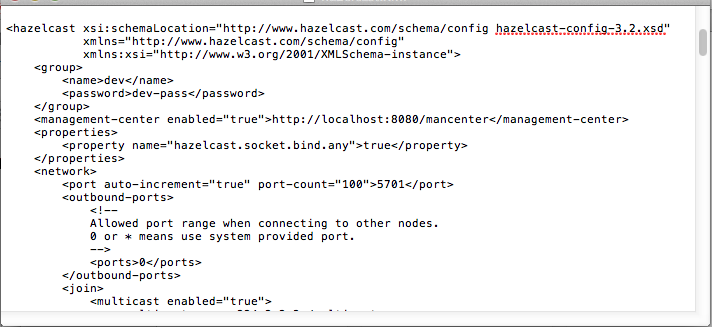Configuring Hazelcast
While Hazelcast is starting up, it checks for the configuration as follows:
First, it looks for
hazelcast.configsystem property. If it is set, its value is used as the path. It is useful if you want to be able to change your Hazelcast configuration. This is possible because it is not embedded within the application. Theconfigoption can be set by the below command:- Dhazelcast.config=<path to the hazelcast.xml>.The path can be a normal one or a classpath reference with the prefix
CLASSPATH.- If the above system property is not set, Hazelcast then checks whether there is a
hazelcast.xmlfile in the working directory. - If not, then it checks whether
hazelcast.xmlexists on the classpath. - If none of the above works, Hazelcast loads the default configuration, i.e.
hazelcast-default.xmlthat comes withhazelcast.jar.
When you download and unzip hazelcast-version.zip you will see the hazelcast.xml in /bin folder. This is the configuration XML file for Hazelcast, a part of which is shown below.

For most of the users, default configuration should be fine. If not, you can tailor this XML file according to your needs by adding/removing/modifying properties (Declarative Configuration). Please refer to Configuration Properties for details.
Besides declarative configuration, you can configure your cluster programmatically (Programmatic Configuration). Just instantiate a Config object and add/remove/modify properties.
RELATED INFORMATION
Please refer to Configuration chapter for more information.
Using Wildcard
Hazelcast supports wildcard configuration for all distributed data structures that can be configured using Config (i.e. for all except IAtomicLong, IAtomicReference). Using an asterisk (*) character in the name, different instances of maps, queues, topics, semaphores, etc. can be configured by a single configuration.
Note that, with a limitation of a single usage, asterisk (*) can be placed anywhere inside the configuration name.
For instance, a map named 'com.hazelcast.test.mymap' can be configured using one of these configurations;
<map name="com.hazelcast.test.*">
...
</map>
<map name="com.hazel*">
...
</map>
<map name="*.test.mymap">
...
</map>
<map name="com.*test.mymap">
...
</map>
Or a queue 'com.hazelcast.test.myqueue';
<queue name="*hazelcast.test.myqueue">
...
</queue>
<queue name="com.hazelcast.*.myqueue">
...
</queue>
